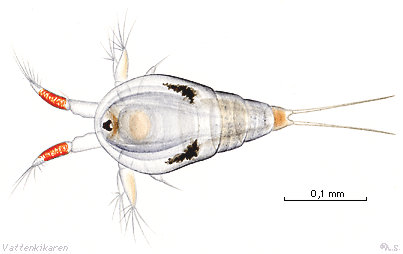|

Distribution in scandinavian waters
|
Maximum length: 0,8 cm. Compare
with the size of a hair.
Appearance: Colour? The nauplius larvae swims with the aid
of three pairs of extremities. The foremost two later develope into
two pairs of antennae. The third pair became parts of the upper jaw
(mandibles). The eye is situated in the middle of the foremost part
of the carapace. Nauplius larvae from different specie of crustacaens
are quite similar, but nauplius larvae of the rankfotingarna
are distinct.
Depth: From sea-level to unknown depth.
Environment: Pelagic.
Misc: Most types of crustaceans hatch as nauplius larvae,
but almost all tiofotade crustaceans hatch into a special type of
”crab larva” known as zoea. There are also crustaceans that
resemble their adult form when they hatch, for example, the opossum
shrimp and märlkräftor.
Nauplius larvae are most common during the summer and
autumn and mainly live on the nutrition provided by the egg. Nauplius
larvae grow and slough their shell several times before they became
another type of larva or get their adult appearance. Many larvae are
eaten by suspension
feeders.
Classification: Nauplius larvae are crustaceans that
belong to the arthropods.
|


